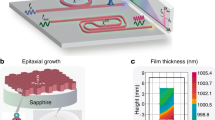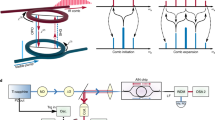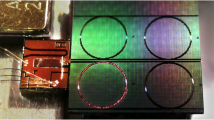Abstract
High-speed actuation of laser frequency1 is critical in applications using lasers and frequency combs2,3, and is a prerequisite for phase locking, frequency stabilization and stability transfer among optical carriers. For example, high-bandwidth feedback control of frequency combs is used in optical-frequency synthesis4, frequency division5 and optical clocks6. Soliton microcombs7,8 have emerged as chip-scale frequency comb sources, and have been used in system-level demonstrations9,10. Yet integrated microcombs using thermal heaters have limited actuation bandwidths11,12 of up to 10 kilohertz. Consequently, megahertz-bandwidth actuation and locking of microcombs have only been achieved with off-chip bulk component modulators. Here we demonstrate high-speed soliton microcomb actuation using integrated piezoelectric components13. By monolithically integrating AlN actuators14 on ultralow-loss Si3N4 photonic circuits15, we demonstrate voltage-controlled soliton initiation, tuning and stabilization with megahertz bandwidth. The AlN actuators use 300 nanowatts of power and feature bidirectional tuning, high linearity and low hysteresis. They exhibit a flat actuation response up to 1 megahertz—substantially exceeding bulk piezo tuning bandwidth—that is extendable to higher frequencies by overcoming coupling to acoustic contour modes of the chip. Via synchronous tuning of the laser and the microresonator, we exploit this ability to frequency-shift the optical comb spectrum (that is, to change the comb’s carrier-envelope offset frequency) and make excursions beyond the soliton existence range. This enables a massively parallel frequency-modulated engine16,17 for lidar (light detection and ranging), with increased frequency excursion, lower power and elimination of channel distortions resulting from the soliton Raman self-frequency shift. Moreover, by modulating at a rate matching the frequency of high-overtone bulk acoustic resonances18, resonant build-up of bulk acoustic energy allows a 14-fold reduction of the required driving voltage, making it compatible with CMOS (complementary metal–oxide–semiconductor) electronics. Our approach endows soliton microcombs with integrated, ultralow-power and fast actuation, expanding the repertoire of technological applications of microcombs.
This is a preview of subscription content, access via your institution
Access options
Access Nature and 54 other Nature Portfolio journals
Get Nature+, our best-value online-access subscription
$29.99 / 30 days
cancel any time
Subscribe to this journal
Receive 51 print issues and online access
$199.00 per year
only $3.90 per issue
Buy this article
- Purchase on Springer Link
- Instant access to full article PDF
Prices may be subject to local taxes which are calculated during checkout




Similar content being viewed by others
Data availability
The data that support the plots within this paper and other findings of this study are available on Zenodo (https://doi.org/10.5281/zenodo.3903724). All other data used in this study are available from the corresponding authors upon reasonable request.
References
Riehle, F. Frequency Standards: Basics and Applications (Wiley, 2006).
Udem, Th., Holzwarth, R. & Hänsch, T. W. Optical frequency metrology. Nature 416, 233–237 (2002).
Cundiff, S. T. & Ye, J. Colloquium: femtosecond optical frequency combs. Rev. Mod. Phys. 75, 325–342 (2003).
Jones, R. J. & Diels, J.-C. Stabilization of femtosecond lasers for optical frequency metrology and direct optical to radio frequency synthesis. Phys. Rev. Lett. 86, 3288–3291 (2001).
Fortier, T. M. et al. Generation of ultrastable microwaves via optical frequency division. Nat. Photon. 5, 425–429 (2011).
Takamoto, M., Hong, F.-L. & Katori, H. An optical lattice clock. Nature 435, 321–324 (2005).
Kippenberg, T. J., Gaeta, A. L., Lipson, M. & Gorodetsky, M. L. Dissipative Kerr solitons in optical microresonators. Science 361, eaan8083 (2018).
Gaeta, A. L., Lipson, M. & Kippenberg, T. J. Photonic-chip-based frequency combs. Nat. Photon. 13, 158–169 (2019).
Marin-Palomo, P. et al. Microresonator-based solitons for massively parallel coherent optical communications. Nature 546, 274–279 (2017).
Spencer, D. T. et al. An optical-frequency synthesizer using integrated photonics. Nature 557, 81–85 (2018).
Xue, X. et al. Thermal tuning of Kerr frequency combs in silicon nitride microring resonators. Opt. Express 24, 687–698 (2016).
Joshi, C. et al. Thermally controlled comb generation and soliton modelocking in microresonators. Opt. Lett. 41, 2565–2568 (2016).
Stanfield, P. R., Leenheer, A. J., Michael, C. P., Sims, R. & Eichenfield, M. CMOS-compatible, piezo-optomechanically tunable photonics for visible wavelengths and cryogenic temperatures. Opt. Express 27, 28588–28605 (2019).
Dubois, M.-A. & Muralt, P. Properties of aluminum nitride thin films for piezoelectric transducers and microwave filter applications. Appl. Phys. Lett. 74, 3032–3034 (1999).
Liu, J. et al. Ultralow-power chip-based soliton microcombs for photonic integration. Optica 5, 1347–1353 (2018).
Riemensberger, J. et al. Massively parallel coherent laser ranging using soliton microcombs. Nature 581, 164–170 (2020).
Kuse, N. & Fermann, M. E. Frequency-modulated comb LIDAR. APL Photon. 4, 106105 (2019).
Tian, H. et al. Hybrid integrated photonics using bulk acoustic resonators. Nat. Commun. 11, 3073 (2020).
Leo, F. et al. Temporal cavity solitons in one-dimensional Kerr media as bits in an all-optical buffer. Nat. Photon. 4, 471–476 (2010).
Herr, T. et al. Temporal solitons in optical microresonators. Nat. Photon. 8, 145–152 (2014).
Stern, B., Ji, X., Okawachi, Y., Gaeta, A. L. & Lipson, M. Battery-operated integrated frequency comb generator. Nature 562, 401–405 (2018).
Raja, A. S. et al. Electrically pumped photonic integrated soliton microcomb. Nat. Commun. 10, 680 (2019); correction 10, 1623 (2019).
Moss, D. J., Morandotti, R., Gaeta, A. L. & Lipson, M. New CMOS-compatible platforms based on silicon nitride and Hydex for nonlinear optics. Nat. Photon. 7, 597–607 (2013).
Fortier, T. & Baumann, E. 20 years of developments in optical frequency comb technology and applications. Commun. Phys. 2, 153 (2019); correction 3, 85 (2020).
Gruhler, N. et al. High-quality Si3N4 circuits as a platform for graphene-based nanophotonic devices. Opt. Express 21, 31678–31689 (2013).
Phare, C. T., Daniel Lee, Y.-H., Cardenas, J. & Lipson, M. Graphene electro-optic modulator with 30 GHz bandwidth. Nat. Photon. 9, 511–514 (2015).
Hosseini, N. et al. Stress-optic modulator in Triplex platform using a piezoelectric lead zirconate titanate (PZT) thin film. Opt. Express 23, 14018–14026 (2015).
Alexander, K. et al. Nanophotonic Pockels modulators on a silicon nitride platform. Nat. Commun. 9, 3444 (2018).
Jin, W., Polcawich, R. G., Morton, P. A. & Bowers, J. E. Piezoelectrically tuned silicon nitride ring resonator. Opt. Express 26, 3174–3187 (2018).
Moille, G. et al. Kerr-microresonator soliton frequency combs at cryogenic temperatures. Phys. Rev. Appl. 12, 034057 (2019).
Xiong, C. et al. Aluminum nitride as a new material for chip-scale optomechanics and nonlinear optics. New J. Phys. 14, 095014 (2012).
Jung, H., Fong, K. Y., Xiong, C. & Tang, H. X. Electrical tuning and switching of an optical frequency comb generated in aluminum nitride microring resonators. Opt. Lett. 39, 84–87 (2014).
Liu, X. et al. Integrated high-Q crystalline AlN microresonators for broadband Kerr and Raman frequency combs. ACS Photon. 5, 1943–1950 (2018).
Gong, Z. et al. High-fidelity cavity soliton generation in crystalline AlN micro-ring resonators. Opt. Lett. 43, 4366–4369 (2018).
Gong, Z. et al. Soliton microcomb generation at 2 μm in z-cut lithium niobate microring resonators. Opt. Lett. 44, 3182–3185 (2019).
He, Y. et al. Self-starting bi-chromatic LiNbO3 soliton microcomb. Optica 6, 1138–1144 (2019).
Wang, C. et al. Monolithic lithium niobate photonic circuits for Kerr frequency comb generation and modulation. Nat. Commum. 10, 978 (2019).
van der Slot, P. J. M., Porcel, M. A. G. & Boller, K.-J. Surface acoustic waves for acousto-optic modulation in buried silicon nitride waveguides. Opt. Express 27, 1433–1452 (2019).
Torres-Company, V. & Weiner, A. M. Optical frequency comb technology for ultra-broadband radio-frequency photonics. Laser Photon. Rev. 8, 368–393 (2014).
Wu, J. et al. RF photonics: an optical microcombs’ perspective. IEEE J. Sel. Top. Quantum Electron. 24, 1–20 (2018).
Aardahl, C. L. et al. Electrical properties of AlN thin films deposited at low temperature on Si(100). Thin Solid Films 346, 174–180 (1999).
Guo, H. et al. Universal dynamics and deterministic switching of dissipative Kerr solitons in optical microresonators. Nat. Phys. 13, 94–102 (2017).
Piazza, G., Stephanou, P. J. & Pisano, A. P. Piezoelectric aluminum nitride vibrating contour-mode MEMS resonators. J. Microelectromech. Syst. 15, 1406–1418 (2006).
Karpov, M. et al. Raman self-frequency shift of dissipative Kerr solitons in an optical microresonator. Phys. Rev. Lett. 116, 103902 (2016).
Yi, X. et al. Single-mode dispersive waves and soliton microcomb dynamics. Nat. Commun. 8, 14869 (2017).
Huang, D. et al. High-power sub-kHz linewidth lasers fully integrated on silicon. Optica 6, 745–752 (2019).
Fichtner, S., Wolff, N., Lofink, F., Kienle, L. & Wagner, B. AlScN: a III–V semiconductor based ferroelectric. J. Appl. Phys. 125, 114103 (2019).
Raja, A. S. et al. Chip-based soliton microcomb module using a hybrid semiconductor laser. Opt. Express 28, 2714–2721 (2020).
Stone, J. R. et al. Thermal and nonlinear dissipative-soliton dynamics in Kerr-microresonator frequency combs. Phys. Rev. Lett. 121, 063902 (2018).
Obrzud, E. & Herr, T. Temporal solitons in microresonators driven by optical pulses. Nat. Photon. 11, 600–607 (2017).
Anderson, M. H. et al. Photonic chip-based resonant supercontinuum. Preprint at http://arXiv.org/abs/1909.00022 (2019).
Acknowledgements
We thank J. Riemensberger, A. Lukashchuk and M. Karpov for discussions. This work was supported by contract HR0011-15-C-055 (DODOS) from the Defense Advanced Research Projects Agency (DARPA), Microsystems Technology Office (MTO), by the Air Force Office of Scientific Research, Air Force Materiel Command, USAF, under award no. FA9550-19-1-0250, and by the Swiss National Science Foundation under grant agreement no. 176563 (BRIDGE). E.L. acknowledges support from the European Space Technology Centre under ESA contract no. 4000116145/16/NL/MH/GM. Samples were fabricated in the EPFL Center of MicroNano Technology (CMi) and in the Birck Nanotechnology Center at Purdue University. AlN deposition was performed at OEM Group Inc.
Author information
Authors and Affiliations
Contributions
J.L., H.T. and R.N.W. designed and fabricated the samples. J.L., H.T., J.H. and T.L. tested the samples and fabrication yield. E.L., A.S.R., J.L., G.L., M.H.A. and W.W. performed experiments. J.L., E.L., A.S.R. and G.L. analysed the data. J.L., T.J.K. and S.A.B. wrote the manuscript, with input from others. T.J.K. and S.A.B. initiated and supervised the collaboration.
Corresponding authors
Ethics declarations
Competing interests
T.J.K. is a co-founder and shareholder of LiGenTec SA, a start-up company that is engaged in making Si3N4 nonlinear photonic chips available via foundry service.
Additional information
Peer review information Nature thanks Matt Eichenfield and the other, anonymous, reviewer(s) for their contribution to the peer review of this work.
Publisher’s note Springer Nature remains neutral with regard to jurisdictional claims in published maps and institutional affiliations.
Extended data figures and tables
Extended Data Fig. 1 Experimental characterization of resonance frequency versus applied voltage.
a, Experimental set-up. OSA, optical spectrum analyser; PD, photodiode. b, Resonance tuning data with error bars. The voltage applied to the AlN actuator is varied in the range ±100 V in order to reveal the hysteresis. The standard deviation (s.d.) of the measured frequency at each voltage value is evaluated using the measured frequency with respect to the fitted frequency on the linear curve. The error bars show ±1 s.d. Inset, magnified view highlighting the difference in scale between the observed hysteresis (that is, the frequency difference between two fitted curves) and the error bars. The overall frequency measurement uncertainty is estimated to be below 15 MHz, smaller than the observed hysteresis.
Extended Data Fig. 2 Characterization of resonance linewidth and microresonator dispersion.
a, Comparison of loaded resonance linewidths with different applied voltages. No voltage-dependent linewidth change is observed. b, Comparison of microresonator dispersion with different applied voltages. No dispersion change is observed.
Extended Data Fig. 3 Long-term soliton stabilization via AlN feedback actuation.
a, Experimental set-up. OSC, oscilloscope; BPF, bandpass filter; FBG, fibre Bragg grating. b, Soliton stabilization over 5 h, realized by locking the resonance to the laser and maintaining the soliton detuning. Three selected comb lines that exist for more than 5 h are shown here.
Extended Data Fig. 4 On-chip generation of PDH error signals using the HBAR modes induced by AlN actuation.
a, Experimental set-up. LPF, low-pass filter; Amp., RF power amplifier. b, The measured S21(ω) response of the AlN actuator on a linear frequency scale. Measurements are taken when the laser is on-resonance and off-resonance. c, PDH error signals modulated at the four HBAR frequencies marked with stars in b.
Extended Data Fig. 5 Experimental set-ups used to characterize the soliton lidar engine and soliton locking.
a, Experimental set-up for the synchronous scan of the laser frequency and the microresonator resonance, using the feed-forward scheme. b, Experimental set-up used to characterize the in-loop phase noise of the beat signal between line no. −1 of the microcomb and line no. −13 of the EO comb. QPSK, quadrature phase shift keying; DSO, digital storage oscilloscope; MZM, Mach–Zehnder modulator; PNA, phase noise analyser.
Extended Data Fig. 6 Original, unprocessed optical micrograph data used to prepare Fig. 1b in the main text
.
Extended Data Fig. 7 Original, unprocessed SEM data used to prepare Fig. 1c in the main text
.
Rights and permissions
About this article
Cite this article
Liu, J., Tian, H., Lucas, E. et al. Monolithic piezoelectric control of soliton microcombs. Nature 583, 385–390 (2020). https://doi.org/10.1038/s41586-020-2465-8
Received:
Accepted:
Published:
Issue Date:
DOI: https://doi.org/10.1038/s41586-020-2465-8
This article is cited by
-
Integrated optical frequency division for microwave and mmWave generation
Nature (2024)
-
Photonic chip-based low-noise microwave oscillator
Nature (2024)
-
High-speed tunable microwave-rate soliton microcomb
Nature Communications (2023)
-
Versatile tuning of Kerr soliton microcombs in crystalline microresonators
Communications Physics (2023)
-
High-speed electro-optic modulation in topological interface states of a one-dimensional lattice
Light: Science & Applications (2023)
Comments
By submitting a comment you agree to abide by our Terms and Community Guidelines. If you find something abusive or that does not comply with our terms or guidelines please flag it as inappropriate.



